Read Reviews
The Best Hand Saws
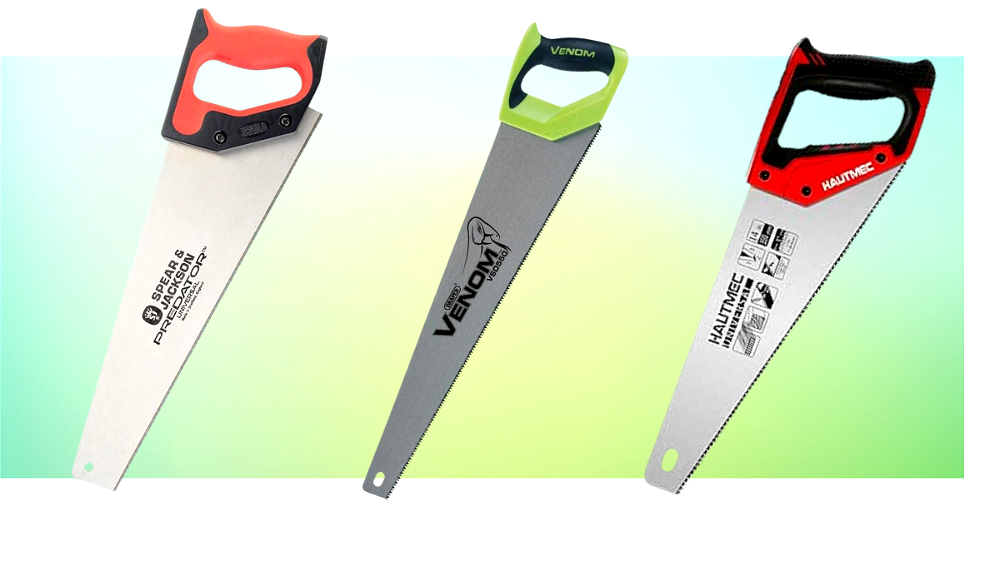
-
Best hand saw with 14 TPI - Spear & Jackson Predator B9814 Second Fix Toolbox Saw
-
Best first fix hand saw - Draper 82196 Venom First Fix Double Ground 7 TPI Handsaw
-
Best second fix with 11 TPI - HAUTMEC X-Sharp Second Fix Hand Saw
-
Best budget hand saw - Irwin Jack 880 Plus UN20 8 TPI Universal Panel Saw
-
Best budget hand saw option - Bahco 244-22-U7/8-HP 7 TPI Hardpoint Handsaw
-
Best hand saw with ruler scale - Presch Second Fix Foxtail 11 TPI Hand Saw
-
Best hand saw for PVC and plastic - STANLEY 217206 300mm FatMax PVC and Plastic Saw
Hand Saw Reviews
1. Spear & Jackson Predator B9814 Second Fix Toolbox Saw
Best hand saw with 14 TPI
- The 14” hardened and tempered steel blade uses hard pointed fine teeth and boasts Spear & Jackson’s patented Duralife technology to extend the useful life of the blade.
- The teeth have been ground with what’s known as fleam. It basically means that the individual teeth have been cut at an angle to slice the wood finely on the push and pull stroke.
- You can use the front side of the handle to measure out both 90° and 45° angles. Simply push the saw handle up to the edge of the timber and mark along the spine of the saw.
- A toolbox saw is ideal when space is at a premium, but a longer saw is much more efficient at cutting. Compared with the Presch second fix saw on my list, it’s going to be slower.
- Having 14 TPI is perfect for making precise straight cuts without causing tear out, but it’s not going to buzz through sleepers. If you’re looking for an all-round saw, this isn’t it.
- Some users have complained about the saw getting blunt too quickly. It’s always an issue with second fix hand saws that have small and finely ground teeth.
- Type
- Second Fix
- Blade
- 406mm / 16"
- Handle
- Suregrip soft feel
- Handle Fixing
- Screwed and welded
- Number of Teeth
- 14 TPI
- Hardened Teeth
- No
- Build Quality
- 5
- Performance
- 5
- Value for Money
- 4
It’s hard to find a business with a longer history than Spear & Jackson. Founded all the way back in 1760, they’re still one of Sheffield’s biggest success stories. With an enormous range of quality hand tools, the B9814 Predator Toolbox Saw is one of the best second fix hand saws that you can get.
With an impressive 14 TPI across its 14″/356 mm length, it has small but razor-sharp fast-cutting fine teeth that work on both the push and pull stroke. With a 0.91 mm thickness, it’s not going to bend and buckle when you’re trying to make your straight cuts. The shorter length but higher tooth count mean you’ve got a saw that’s easy to transport around, but still leaves a silky smooth finish for your second fix work.
Spear & Jackson have used their patented Suregrip soft feel handle on this saw, which promises to minimise hand fatigue and cut down on vibrations that can make you wander off the cut line. Not only has it been screwed and welded on for improved durability, but the soft grip section extends forward from the handle to give you a solid finger guide as well. It’s an excellent saw that belongs in any DIYers toolkit.
Did you find this review helpful?
2. Draper 82196 Venom First Fix Double Ground 7 TPI Handsaw[ SAVE 40% ]
Best first fix hand saw
- Draper have used a tough lacquer to coat the saw blade. It works in two ways; it helps stop the blade from rusting out and reduces friction during use for faster cuts.
- The 8 TPI blade is incredibly sharp and aggressive, which makes it ideal for first fix work. It can chew through timber quickly thanks to the hardened and tempered blade.
- Like most modern hand saws, you can use the front of the handle to make 90° and 45° marks. Team it up with a pencil and you’ve also got a handy layout tool in your hand.
- Compared with the triple ground teeth on the Irwin Universal Plus 880, this saw doesn’t cut on the backstroke. Even though it has aggressive teeth, they’re not as efficient.
- The handle has a comfortable grip surface on it, but it’s a bit narrow if you’ve got large hands. It’s not such an issue if you’re wearing gloves, but a first fix saw can handle being a bit chunkier.
- A 1 mm blade is rather thin blade for an aggressive saw like this. Several users have complained about too much flex, which can make the saw bind up in the workpiece.
- Type
- First Fix
- Blade
- 550mm / 22"
- Handle
- Soft grip
- Handle Fixing
- Welded
- Number of Teeth
- 8 TPI
- Hardened Teeth
- Yes
- Build Quality
- 4
- Performance
- 4
- Value for Money
- 5
With more than a century of service, British tool firm Draper make all sorts of power tools, hand tools and safety gear as well. Their range of saws includes the mighty Venom 82196 first fix handsaw. With its 550 mm length and 1 mm thin blade it’s the perfect saw for getting through big pieces of timber quickly.
The handle has been designed with a bi-material ergonomic soft grip section. It’s comfortable and has a textured surface on the front side to keep it stuck to your hand, even without gloves on. The saw blade itself is made from Japanese SK5 mid carbon steel, an ideal material for this type of tool.
With a double ground set of teeth on the 7 TPI blade, the real benefit of this saw compared to other first fix ones is the extra length. Measuring 550 mm, you can get a longer stroke and push the saw through wood, plasterboard, and plastics quickly and efficiently.
Did you find this review helpful?
3. HAUTMEC X-Sharp Second Fix Hand Saw
Best second fix with 11 TPI
- You’re not limited to just cutting wood with this saw. The sharp teeth will make short work of laminate, composite, MDF and plastics as well.
- I think that 11 TPI is the ideal tooth count for DIYers that want a clean and precise cut. It’s still robust enough to be a useful all-rounder saw if you don’t mind a bit of hard work.
- The triple-ground teeth are set so you can make rip cuts as well as cross cuts. It will effectively cut on the pull stroke as well as the push stroke.
- The blade length on this saw is really short! Unless portability is your main priority, I would usually go for a longer cutting blade saw.
- Some users have complained that this saw doesn’t stay on the cut line as well compared with the Spear & Jackson Predator. It could be an issue with technique though.
- At 454 g, this isn’t exactly a heavy saw. But in comparison with the Spear & Jackson Predator, it’s nearly 150 g heavier. If weight is a concern, this one’s a touch heavy.
- Type
- Second Fix
- Blade
- 406mm / 16"
- Handle
- Bi-material
- Handle Fixing
- Screwed
- Number of Teeth
- 11 TPI
- Hardened Teeth
- Yes
- Build Quality
- 4
- Performance
- 4
- Value for Money
- 4
With an impressive range of moderately priced hand tools, it’s not hard to believe that HAUTMEC make one of the best budget second fix hand saws. The X-Sharp hand saw is another useful toolbox size saw that is lightweight and very capable.
Boasting a thick blade for better stability, a toolbox friendly 16″/400 mm blade length and 11 TPI, this is the best hand saw for getting into tight spots and out of problems. The saw blade has been polished as well as lacquered, which should help to reduce friction and get through timber that bit quicker.
I was really impressed by the quality of the handle on this saw. It’s a bi-material construction with plenty of grip and a lip on the top that holds the webbing of your hand nicely. It’s been screwed onto the handle and has plenty of room for large hands wearing gloves.
Did you find this review helpful?
4. Irwin Jack 880 Plus UN20 8 TPI Universal Panel Saw[ SAVE 59% ]
Best budget hand saw
- The ProTouch soft grip makes this an easy saw to handle, even without gloves on. It reduces the chance of getting blisters and helps line your arm up with the saw for accuracy during the cutting process..
- With an increased grip circumference compared to a lot of other hand saws, it feels like it’s built for hard work. This is even more welcome if you’ve got large hands like mine!
- It’s quite amazing how Irwin manages to manufacture a quality saw like this for such a reasonable price. Once it eventually goes blunt, buying a new one isn’t going to bankrupt you.
- The Irwin Jack Plus range of hand saws have uprated handle designs and thicker grips, and also feature colour coded handles. The orange handle is on the universal saw, the green is coarse, and the purple handle is found on the fine tooth saw blade.
- Don’t expect the earth from a saw that costs this much. It’s a first fix hand saw, so it’s not designed for fine work. It will leave a slightly wider kerf compared with the Presch 10035.
- The triple cut razor blade teeth are designed for cross cutting wood across the grain. If you try to make a rip cut along the grain, you’ll struggle to make quick progress.
- If you’re used to re-sharpening your hand saws once they blunt, you won’t like this saw. The process of hardening the teeth make them too brittle for working on more than once.
- Type
- First Fix
- Blade
- 500mm / 20"
- Handle
- Soft grip
- Handle Fixing
- Welded
- Number of Teeth
- 8 TPI
- Hardened Teeth
- Yes
- Build Quality
- 4
- Performance
- 4
- Value for Money
- 5
Famous for their locking pliers, Irwin also makes a huge range of hand tools for professional tradespeople and DIYers as well. The Irwin Jack 880UN20 universal panel saw is an inexpensive and quality hand tool that is found just about everywhere on site and in workshops.
Boasting one of the best saw handles in the business, it’s designed with the ideal angle to get your hand and arm in the right place for accurate and fast straight cuts. The patented ProTouch grip found on lots of Irwin hand tools has a soft surface for comfort and grip. It can really speed up your first fix work in both soft and hard woods, and the increased handle hole size makes it compatible with gloved hands.
The 500 mm 8 TPI blade is made from German high carbon steel, and triple-ground teeth that cut on the pull as well as the push stroke. The blade isn’t too rigid or too flexible, allowing you to transfer maximum energy to the cutting surface. It’s a whole lot of saw for not a lot of money.
Did you find this review helpful?
5. Bahco 244-22-U7/8-HP 7 TPI Hardpoint Handsaw
Best budget hand saw option
- The universal tooth set on this saw makes this a more versatile first fix tool. It means it can rip cut along the wood grain just as well as cross cut across the grain.
- With high frequency induction hardened teeth, this hard point saw is built to stay sharper for longer. You can’t re-sharpen them, but the saw should still last for a long time.
- With 8 PPI and 7 TPI, this saw strikes a balance between power and user comfort. It’s easy to start sawing, and once you get into a rhythm it sails through wood like it’s not there.
- Compared with the Draper 82196, you can’t easily point your index finger along the line of this saw. It’s a good technique for sawing straight, so it’s a shame it’s not built in like the Viper saw.
- It’s a bit strange that Bahco have opted for a screwed-on handle for this saw. Hard point saws can’t be re-sharpened, and at this price point you’d just buy a new saw rather than swap the blade out.
- The handle on this saw hasn’t got a rubberised grips section compared with the Irwin Jack Plus. The hard ABS-type plastic used isn’t optimised for comfort during long sawing jobs.
- The drawback of a hard point saw is if you happen to hit a nail or screw when you’re sawing through some timber. The teeth are likely to snap off or otherwise be completely blunted.
- Type
- First Fix
- Blade
- 550mm / 22"
- Handle
- Bi-material
- Handle Fixing
- Screwed
- Number of Teeth
- 7 TPI
- Hardened Teeth
- Yes
- Build Quality
- 4
- Performance
- 4
- Value for Money
- 5
The Swedish tool brand with the fish on the logo, Bahco are well respected for making quality hand tools. They make some of the best hand saws in all different price brackets, and the Bahco 244-22-U7 hand saw is a fine example of an inexpensive but high-performance tool.
The basic plastic handle doesn’t look like much, but it’s screwed onto the saw blade which some users prefer. Made in Sweden, it weighs just 475 g and is designed for cutting through medium to thick pieces of wood. It’s one of the best first fix hand saws, and it’s not expensive either.
The universal tooth set is great for rip cuts and crosscuts, and the long 550 mm blade makes light work of materials including chipboard, MDF, OSB, and proper timber. The high-frequency, induction-hardened teeth are super sharp and really show what a hard point saw is all about.
Did you find this review helpful?
6. Presch Second Fix Foxtail 11 TPI Hand Saw
Best hand saw with ruler scale
- I’ve often used the ridge of a hand saw as a quick straight edge when working. Presch have gone an extra step and added a ruler scale up to 32 cm. I love it when tools perform multiple functions like this!
- Alongside being able to use the front of the handle to make quick 90° and 45° marks, Presch have also printed an accurate triangle diagram on the blade. It’ll help with laying out.
- Most hand saws come with this feature, but it’s still worth a mention. The sleeve that the saw comes in can be used as a case, and the hole in the saw blade means you can hang it up.
- Compared with the 550 mm blade on the Bahco 244 hand saw, this one is closer to a “toolbox” size at 450 mm. The shorter the stroke, the less momentum you can build up for fast cuts.
- This is pretty expensive for a hard point saw. You can’t re-sharpen it and compared with the low price of the Irwin Jack 880 Plus, it’s not quite as fast when cutting through big timbers.
- Fine tooth hand saws that are around 11 TPI are not as versatile as universal tooth saws. The finer teeth are good for precision work, but don’t try and rip cut with this saw, it’ll take too long.
- Type
- Second Fix
- Blade
- 450mm / 18"
- Handle
- Bi-material
- Handle Fixing
- Screwed
- Number of Teeth
- 11 TPI
- Hardened Teeth
- Yes
- Build Quality
- 4
- Performance
- 4
- Value for Money
- 4
German engineering firm Presch are making waves in the DIY world with their quality kit. This second fix “foxtail” type hand saw is no exception, it’s razor-sharp and ideal for when you need an extra bit of precision.
The quality bi-material handle deserves a special mention. It’s well sculpted with plenty of soft rubberised grip sections and a scalloped part for your index finger on both sides. It’s screwed onto the 450 mm blade in three places and means you can make both fine and rough cuts.
With 11 TPI to play with, the individual teeth are specially hardened for fine work. There’s less chance of tear-out, even if it’s not going to cut through big timbers as quickly compared with the first fix saws on my list.
Did you find this review helpful?
7. STANLEY 217206 300mm FatMax PVC and Plastic Saw
Best hand saw for PVC and plastic
- You can’t beat using the right tool for the right job. A universal saw like the Irwin Jack 880 can do a lot of jobs, but if you want to cut a lot of plastics, this saw’s hard to beat.
- STANLEY’s FatMax range of tools are built tough for trade use and feature much chunkier parts to make them easy to use, even with gloves on. They last for ages as well.
- Using a “normal” hand saw for plastics can be a nightmare. Set teeth that splay out leave horrible burrs, and the plastic swarf can clog up the blade teeth easily.
- This is a specialist saw. Unless you’re planning to cut a lot of plastic materials, it’s hard to justify the spend and space it’ll take up. A universal saw will get the job done if it’s just for occasional use.
- The 300 mm long blade is the shortest on my list. It’s fine for getting into tight spots and for fiddly jobs, but it’s much slower compared with the Draper 82196’s long 550 mm blade.
- Compared with the tri-ground teeth on the Irwin Jack 880, this saw only cuts on the pull stroke. This method of sawing doesn’t suit everyone and can be a pain to learn.
- Type
- Second Fix
- Blade
- 300mm / 12"
- Handle
- Bi-material
- Handle Fixing
- Screwed and welded
- Number of Teeth
- 11 TPI
- Hardened Teeth
- Yes
- Build Quality
- 4
- Performance
- 4
- Value for Money
- 4
DIY brands don’t get much bigger and better known than STANLEY. With close to 180 years of service under their belt, there isn’t much they don’t know about making the best hand saws. The 217206 FatMax PVC and plastic saw is a specialist bit of kit for DIYers that are dealing with things like waste pipe and polycarbonate sheets.
With a totally different shape to the hand saws on the rest of my list, you can tell straight away that this is a particular saw for a special job. The shape of the handle means you can cut sheet materials easily without changing your hand position. The bi-material used in the handle is comfortable and non-slip too.
Making use of an 11 TPI saw blade, there’s no set to the teeth. This means they don’t splay out, making a thin kerf and helping to avoid burrs in the final cut. With induction hardened teeth for long life, it’s a 300 mm long saw that will make short work of PVC and other plastic materials.
Did you find this review helpful?
Compare Product Features
Use the dropdown to sort the table by the feature you want to see.
Spear & Jackson Predator B9814 Second Fix Toolbox Saw
- 4.7
- Second Fix
- 406mm / 16"
- Suregrip soft feel
- Screwed and welded
- 14 TPI
- No
Draper 82196 Venom First Fix Double Ground 7 TPI Handsaw
- 4.3
- First Fix
- 550mm / 22"
- Soft grip
- Welded
- 8 TPI
- Yes
HAUTMEC X-Sharp Second Fix Hand Saw
- 4
- Second Fix
- 406mm / 16"
- Bi-material
- Screwed
- 11 TPI
- Yes
Irwin Jack 880 Plus UN20 8 TPI Universal Panel Saw
- 4.3
- First Fix
- 500mm / 20"
- Soft grip
- Welded
- 8 TPI
- Yes
Bahco 244-22-U7/8-HP 7 TPI Hardpoint Handsaw
- 4.3
- First Fix
- 550mm / 22"
- Bi-material
- Screwed
- 7 TPI
- Yes
Presch Second Fix Foxtail 11 TPI Hand Saw
- 4
- Second Fix
- 450mm / 18"
- Bi-material
- Screwed
- 11 TPI
- Yes
STANLEY 217206 300mm FatMax PVC and Plastic Saw
- 4
- Second Fix
- 300mm / 12"
- Bi-material
- Screwed and welded
- 11 TPI
- Yes
How to Choose the Best Hand Saw
Hand saws may look like very simple tools, but their usefulness and versatility when it comes to DIY work are virtually unmatched. Whether you’re cutting up logs or making furniture, a hand saw will almost certainly help you out. They require no electricity and very little maintenance, making them an extremely affordable addition to your tool shed!
What are Hand Saws Used For?
Hand saws are versatile tools that can be used for many tasks, including cutting hardwood, softwood, plywood and MDF. Whether you’re chopping wood for the fire or making your own coffee table, a good hand saw will make the task a lot easier. While they do require some physical exertion to use, selecting the correct hand saw for the task will make the process a lot more comfortable.
Types of Hand Saws
There are a few different types of hand saws on the market.
Coping saws are used for cutting through hard and soft wood, plastic, ceramic and some metals. These are very versatile so if you’re not sure what you’re going to be using your hand saw for the most, a coping saw is a good option. The blades are replaceable, so you should find these saws are good value for money and last a long time.
Bow saws produce a rougher finish as they are designed for faster cutting. These are used mainly for tree branches and logs for fires, where a smooth finish isn’t necessary.
Tenon saws are used for both hard and soft wood where precision is needed. They produce a neat finish and offer the user full control as the blade doesn’t flex. These are suitable for making deep and accurate cuts in joinery.
Hacksaws are very versatile, able to cut pipe, steel rods, PVC and bolts. These are suitable for cutting hard materials so are mainly used by professionals.
Crosscut or rip cut saws utilise a different technique. If you are cutting across the wood grain, this tool is best. The teeth are angled backwards, so the cut is both on the push and pull strokes.
Pruning saws are used around the garden to neaten up tree branches and shrubs.
Construction Quality
Construction quality is going to be key when it comes to the longevity of any hand saw, and a good quality saw may also be easier to use.
The first thing to look at is the blade quality. Ideally, the blade should be made from hardened steel.
The blade should flex slightly when you bend it, straightening immediately when you let it go. Longer blades may flex more at the ends than shorter blades, so you’ll have slightly less control. Thicker blades create more stability but will cut away more material at any time. Thinner blades don’t cut away as much material, but they can be harder to control.
Length
The length of the saw is also very important. Hand saws can vary in length from around 6” to 24”. The length of the blade itself is worth looking at.
Saws with long blades are designed for long strokes. These are more efficient when cutting larger pieces of wood, but they require more movement from the user.
Saws with shorter blades are better for smaller pieces of wood or plastic. These require less overall movement from the user but can be less efficient.
For very precise work, a shorter saw is preferable. You’ll have more control over the end of the blade which can lead to a neater finish. If you’re sawing logs for the fire and there’s no need for precision, a longer saw will be more efficient.
It’s also worth considering your frame when deciding on the best length of saw. Someone who is 6’2″ will prefer a different saw to someone who is 5’5″. The taller person will naturally have a longer saw stroke, and the saw you choose will need to be a couple of inches longer than this length.
Number of Teeth
The number of teeth in your hand saw is also important. However, it’s important to note that simply referring to the number of teeth doesn’t tell us much, as hand saws can vary so enormously in length.
Instead, we need to look at ‘teeth per inch’ or TPI. This number typically varies from 7 to 14 TPI. The more teeth per inch, the cleaner and more precise cut you will achieve. A saw with fewer teeth will be more efficient, but you’ll sacrifice accuracy and a neat finish.
For general wood cutting, a lower number of teeth is better.
Push or Pull Stroke Cutting
The process of sawing requires both a forward and backward stroke, a push and a pull.
Push-stroke saws are generally used for cutting through tougher materials such as hardwood.
Pull-stroke saws have thinner blades and are designed for more delicate cuts. You should have more control pulling the saw towards you, allowing you to make more precise cuts with a neat finish. The blade is likely to be thinner and more delicate, however, so more care will be needed.
Some saws cut on both the push and the pull stroke. If the teeth are neither angled backwards nor forwards, the saw likely cuts on both the push and the pull. Saws that cut on both push and pull are used for fast and aggressive sawing, where speed is more important than the finish.
Handle Comfort
Comfort and balance between the handle and the blade are important. The saw shouldn’t feel top-heavy, and you should be able to get a good grip on the handle. Some handles have rubber grips to prevent slipping.
While handle comfort is important, a lot of what makes sawing easy is the technique. Ensure you have a good grip on the handle and don’t put excess pressure on the blade.
Hand Saw FAQs
When using a hand saw for cutting wood use the following tips for a nice straight cut.
Work on a solid workbench or table. If the table wobbles or moves this is not only potentially dangerous but will also affect the straightness of your cut.
Secondly, secure the workpiece to the workbench with clamps. If the workpiece moves around as you are sawing the cut will not be accurate.
Thirdly, draw a line to follow. You can use a yardstick and a triangle to mark your line or use the angle on the handle of your hand saw and the back of the saw blade.
Now you are ready to start the cut.
Keep your index finger on the side of the hand saw to give you more control. Your wrist, elbow and shoulder should be aligned with the blade. Begin by making two or three upward strokes with the hand saw until the teeth start to bite into the wood.
If you are cutting with the grain hold the hand saw at a 60% angle. If you are making a cross-cut, against the grain, then hold the saw at a 45% angle. Work the hand saw back and forward to cut the wood using the whole length of the blade. Do not force the blade – let the hand saw do the work for you. This will result in a neater cut. As you approach the end of the cut shorten your stroke to use only half the blade in order to prevent splintering or splitting.
Wearing thick work gloves, clean the blade of your hand saw with soapy water and a stiff brush and wipe it dry.
Hand saws can be sharpened with a taper file. A jaw set is also useful for resetting the teeth. You will also need a clamp to hold your hand saw.
You can buy saw-sharpening file sets quite easily. Then it’s just a matter of clamping your hand saw and filing all the teeth one way, then turning the hand saw for filing in the other direction.
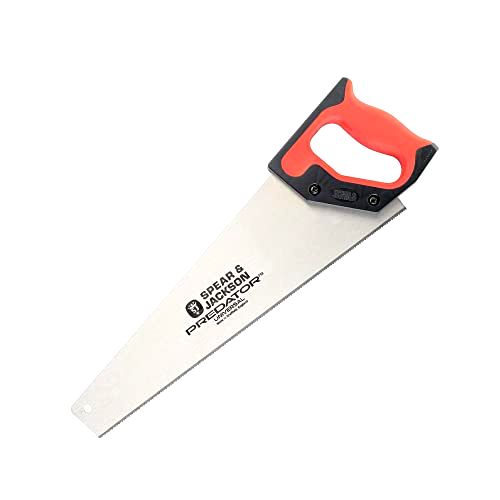
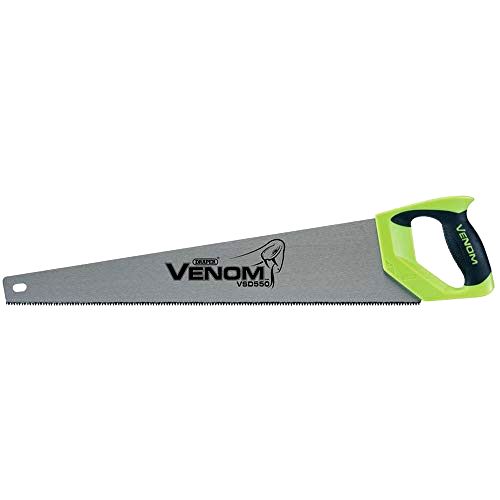
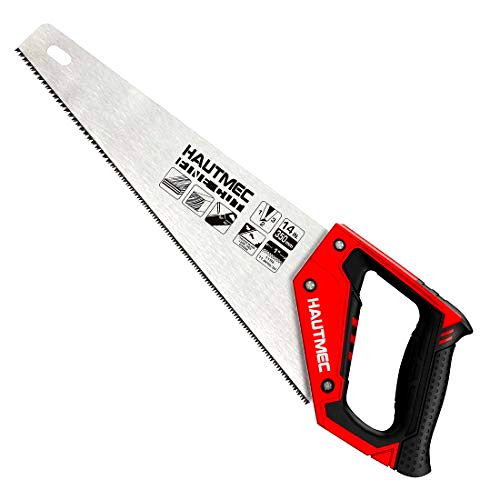
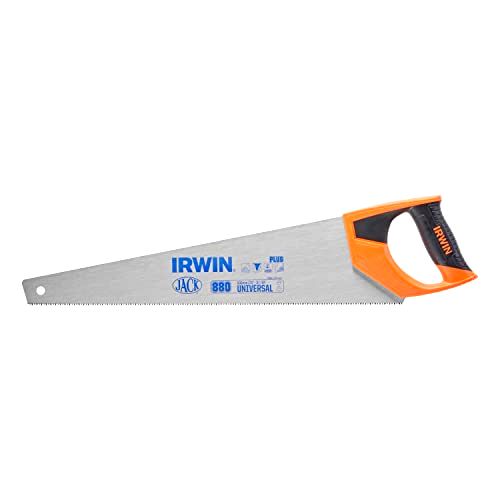
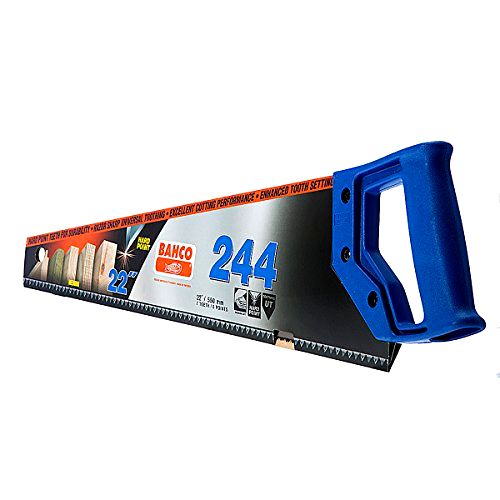
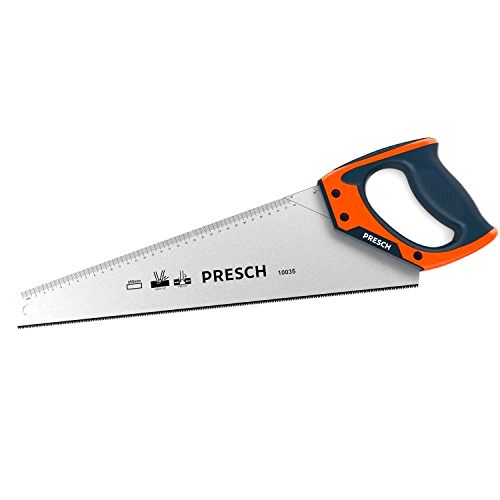


Share